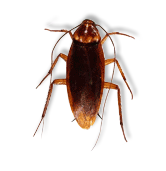General Characteristics:
- Adult roaches are reddish brown in colour and are about 2 inches long
- They have large wings that entirely cover their abdomen and a pale beige coloured “halo like” band around their pronotum
- Nymphs are 1/4 inch long when they hatch and are grayish brown. As they mature they darken and the “halo” becomes visible
Reproduction:
- Each egg capsule contains 14-16 eggs
- A mature female can lay between 15 and 90 egg capsules in their lifetime some of them as little as a week apart
- After 50-55 days the nymphs hatch. Depending on environmental conditions the nymphal stage lasts from 160-971 days.
- As an adult the American cockroach can live for 12-15 months. Due to this combination of longevity and the laying of many egg capsules relatively quickly populations can explode, particularly in areas of a structure not visited regularly.
Signs of Infestation:
- These pests are good flyers/gliders, however, they seldom do
- They like to congregate in warm, damp areas like sewers, steam tunnels, boiler rooms, sump pits, floor drains, pipe chases, near bathtubs, etc.
- Their fecal droppings look virtually identical to that of a mouse only with a slightly more shiny appearance
- American cockroaches can feed on many different foods from decaying organic matter, sugars and sweets, book bindings, paper containing starch, even some clothing items
Control Techniques:
- Indoor infestation of this species is usually caused by excessive heat, cold or rainfall
- As it is quite difficult to limit the food and water source for this species, sealing the structure acts as an effective way to minimize access. PLEASE REMEMBER NOT TO SEAL ANY STRUCTURAL BREATHING HOLES AS THESE ARE NECESSARY FOR THE MOVEMENT OF MOISTURE THROUGH VOID AREAS IN A STRUCTURE.
- Chemical methods are generally necessary for control of this species.
Please click here to contact a Focus Pest Control professional to inquire about further treatments for this pest species.
References:
Benett, Gary W., et.al.. Truman’s Scientific Guide to Pest Control Operations. Duluth: Advanstar
Communications, 1988. Pp. 132, 137-142.
Disclaimer:
The Focus Pest Control ‘Pest Library’ is an educational resource written largely to educate the general public about common pests in Ontario. The Focus ‘Pest Library’ does not include all species in Ontario, nor does it include the most recent scientific data about species we describe. Though we edit our accounts for accuracy, we cannot guarantee all information in those accounts. While Focus Pest Control staff and contributors provide references to books and websites that we believe are reputable, we cannot necessarily endorse the contents of references beyond our control.
(Back to top) |


